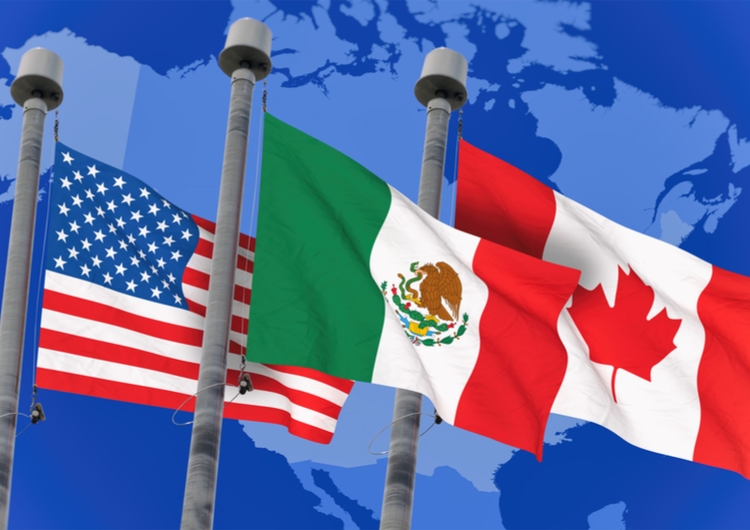Trump and Trade – Mid NAFTA Negotiation

Rounds one through five of the schedule six rounds of NAFTA trade talks have now been completed and we have much clearer insight into the Trump Administration’s agenda. The parts of it that Canada and Mexico will find hard to live with were further highlighted in the release of an updated Summary of Objectives issued by the Office of the United States Trade Representative, Robert E. Lighthizer.
Major changes from the previous version of the document released five months ago include, by topic:
- Ensuring that the rules of origin for auto parts promote production in North America and, more specifically, in the United States: The current demand is that cars must include 50 per cent U.S. content and 85 per cent content from North America overall, to avoid a tariff.
- Ensuring reciprocity in market access for public-works contracts: The current U.S. position is that the ability of Canadians and Mexicans to bid for U.S. public contracts would be limited to dollar limits equal to the value of Canadian and Mexican public contracts won by U.S. bidders.
- Eliminating Canadian tariffs on imports of dairy, poultry and egg products: This would trigger the end of the Canadian supply management system, which is a political non-starter for all Canadian federal political parties.
- Elimination of the Chapter 19 dispute settlement system: The dispute settlement mechanism is a cornerstone of the Canadian free trade agenda.
- An obligatory review of NAFTA every five years, during which any party could terminate the arrangement unilaterally: While this is not so different from the status quo in practical terms, the intention is to make the arrangements unstable. That likely means that investment decisions made under NAFTA with this clause would necessarily have a shorter time horizon.
The United States has moderated its language on the review mechanism it had originally proposed and is now focused on “periodic review,” rather than a 5 year up or out mechanism. This could be a sign that compromise is possible or it could just be a softer way of saying the same thing.
The recently completed fifth round of talks made progress in more technical areas where the interests of the parties are aligned. If you are going to trade at all, you might as well do it with a common set of measures and modern communications.
The sixth and last scheduled round of talks will be in Montreal this month. Where there was cautious optimism earlier in the talks, there is now a growing consensus that these talks cannot succeed given the U.S. positions outlined above. Stephen Harper has written a memorandum titled “Napping on NAFTA,” in which he predicts failure and urges Canada to pursue a bilateral agenda with the United States. Many Conservative politicians appear to support that view, but Canada has remained officially committed to the trilateral process.
Canada’s current plan is to present evidence to the United States that its position on the auto sector would destabilize the North American manufacturing industry to the detriment of all. Chrystia Freeland, Canada’s Foreign Minister, has described the Canadian approach as “fact based.” It analyses the automotive industry and the U.S. proposals and states that the facts:
- do not support that there is a problem with the U.S. auto manufacturing industry;
- indicate that the proposed measures would be counter-productive even if there were; and
- indicate that the proposed content rules could not be met by any automotive manufacturer at this time or in the near future without significant disruption.
The idea is that the U.S. Administration, confronted with the facts, will say “Oh gosh, what were we thinking?” and retreat from their position. This seems unlikely, particularly since demonizing trade was a major plank of the Trump platform.
President Trump’s political base is not interested in facts that require analysis of complex global markets and economic trends. The gut feeling of many Americans is that things for them and their communities have not been getting better. The Administration has targeted “unfair” trade agreements and immigration as the key sources of that decline and, sadly, many agree. It would be as politically difficult for this Administration to back down from their position on trade as it would be for Canada and Mexico to accept it.
Some argue that the U.S. hardline position is intended to be very tough with the strategic goal of getting Canada and Mexico to offer something that is somewhere in the middle between doing nothing and doing what America wants. It is a classic Trump negotiating technique. You have to believe that he would do the crazy things he threatens in order to get you to take a position you may not like, but can live with. That may be true, but.
It is important when employing hardball tactics like the U.S. negotiating team is doing that you not overstep. If your offer takes too much from the other side, they may simply refuse to trade. You need to be in the zone. And that is what the Mexicans and Canadians have been saying. They would like to be flexible, but the flexibility cannot start with the current U.S. position.
My view is that issuing a notice to terminate NAFTA is a no-cost option for the President. Offer a deal that is very good for the United States and, if the others buy it, all is good. If they do not, label them as whining liberals and cheats and terminate NAFTA. I would not expect a whole lot of backing down. My money is on NAFTA failure and a drawn out termination process with lots of Congressional involvement. Many believe that the U.S. Congress will rescue NAFTA, but I am not so sure. There is lots of grass roots support for the idea of more restrictive trade. My guess is that NAFTA might survive in some manner, perhaps for a transitional period, but the likelihood of achieving a reboot of liberal trade with America in this environment is very low.
It would appear that Chrystia Freeland agrees that termination is a likely outcome and has adopted a new tactic. Canada has lodged a complaint before the World Trade Organization (WTO) regarding the United States’ approach to anti-dumping and subsidization rules. The Canadian complaint is made in connection with the long-running softwood lumber dispute between Canada and the United States, but cites 180 cases over 20 years, many of which involve trade with countries other than Canada.
This move is being seen as an indication to the United States of what it can expect from Canada if the NAFTA talks fail. If the WTO were to agree with Canada’s complaint, billions of dollars of foreign goods would flood into the United States. Robert Lighthizer, the lead negotiator on NAFTA for the United States, has pointed out that this would be bad for Canada as well as the United States. However, it would be worse for the United States than Canada. This is perhaps an exercise in giving a bully a taste of his own medicine.
I doubt that this tactic will save these talks, but it might give the Administration pause. It will be interesting to see what this round of talks brings.
Although the termination or restriction of NAFTA would be negative for Canada in the short term, it also presents an opportunity. The decades-long commitment of the United States to global trading has resulted in the formation of multinational corporations designed to exploit that trade, most of which are American. The multinationals do not want America to build trade walls and to lose access to foreign markets. Canada should be speaking seriously to U.S. multinationals. These corporations will need a base from which to trade with the world. Canada could be that base. We have a stable country with an international focus and a collection of very interesting free trading agreements. Having a few of those companies establish a beachhead in Canada would soften the blow from the termination of NAFTA. It might even bring new energy to the Canadian economy in industries suited to the 21st century rather than the 20th.

